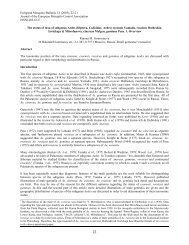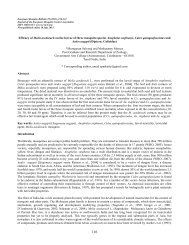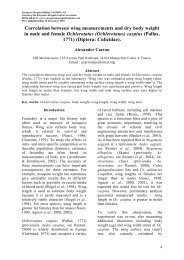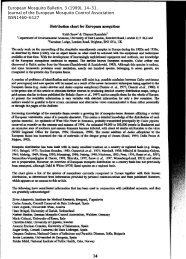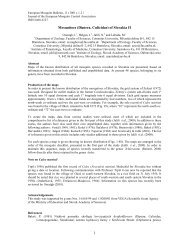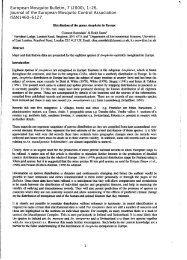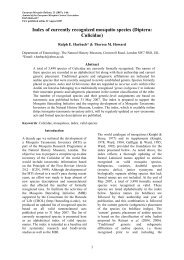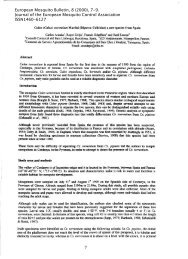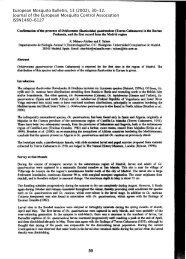Introduction<strong>Culex</strong> <strong>pipiens</strong> L. is one <strong>of</strong> the most common <strong>and</strong> widespread Holarctic mosquitoes, with adistribution covering all temperate regions. Two biotypes with many behavioural differencesare present in its Palaearctic distribution, the anautogenous, ornithophic Cx. <strong>pipiens</strong> nominatebiotype, <strong>and</strong> the autogenous, strongly anthropophilic, Cx. <strong>pipiens</strong> molestus biotype. Formerlyregarded as separate taxonomic entities, lack <strong>of</strong> diagnostic morphological characters led tothe current classification. Though regarded as ornithophilic, occasional feeding on humans<strong>and</strong> other mammals has been observed by the nominate biotype (Gingrich & Casillas, 2004,Petric et al., 1999). <strong>Culex</strong> <strong>pipiens</strong> biotype molestus is autogenous <strong>and</strong>, stronglyanthropophilic. Formerly known as Cx. molestus Forskal, the absence <strong>of</strong> reliablemorphological diagnostic characters led to its current taxonomic ranking (Harbach &Harrison, 1984, Becker et al., 2010). The molestus biotype is largely an urban mosquito inthe extensive northern parts <strong>of</strong> its distribution, where it is almost exclusively confined tohypogeal aquatic developmental sites, quite different from the surface or more or less elevatednatural <strong>and</strong> container habitats used by the nominate biotype <strong>of</strong> Cx. <strong>pipiens</strong>The morphologically similar <strong>Culex</strong> <strong>torrentium</strong> Martini occurs in Western Palaearctic regionswhere, due to its close resemblance to Cx. <strong>pipiens</strong>, the situation is confused. The species wasnot described until 1925, a date when mosquito systematics were already well advanced(Harbach et al., 1985). The variable numbers <strong>and</strong> lengths <strong>of</strong> larval setae <strong>and</strong> observeddifferences in egg rafts morphology are not sufficiently diagnostic (Dahl, 1988). Becker et al.(2010) describe differences in the number <strong>of</strong> larval setae with diagnostic relevance, but wellpreserved samples are needed. Almost all morphological characters <strong>of</strong> males are variable <strong>and</strong>overlapping (Dahl, 1988). Mohrig (1969) mentioned differences in wing vein shape, but suchcharacters can only be used by specialists. Morphological differences in the dorsal arms <strong>of</strong>the aedeagus <strong>of</strong> adult males are the only reliable diagnostic characters separating Cx.<strong>torrentium</strong> from Cx. <strong>pipiens</strong> (Mohrig, 1969, Becker et al., 2010).Field studies are difficult when morphological identification <strong>of</strong> species is tedious <strong>and</strong> unsure.Thus knowledge about the quantitative, spatial <strong>and</strong> temporal distribution <strong>of</strong> both species isincomplete <strong>and</strong> they may have been confused in former studies (Vinogradova et al., 2007).These species are not separated in many publications <strong>and</strong> are sometimes h<strong>and</strong>led as bundles<strong>of</strong> “Cx. <strong>pipiens</strong>/<strong>torrentium</strong>” (e.g. Schäfer et al., 2004), or the presumptive existence <strong>of</strong> Cx.<strong>torrentium</strong> seems to have been neglected (e.g. Rydzdanicz & Lonc, 2003), or collectors wereoverwhelmed by high densities <strong>of</strong> Cx. <strong>pipiens</strong>, particularly when females from CO 2 -trapcollections were studied (Petric et al., 1999). Therefore it is essential to consider geneticmarkers.Vector surveys <strong>and</strong> control programmes require separation <strong>of</strong> the clearly ornithophilic Cx.<strong>torrentium</strong> <strong>and</strong> the partially anthropophilic <strong>Culex</strong> <strong>pipiens</strong>. Since West Nile virus outbreaksbecame epidemic in the USA <strong>and</strong> in parts <strong>of</strong> Europe, the zoogeography, taxonomy <strong>and</strong>identification <strong>of</strong> species <strong>of</strong> Cx <strong>pipiens</strong> s.l. <strong>and</strong> related taxa have received high attention.Sindbis virus has been detected recently in a Cx. <strong>torrentium</strong> population in Germany (Jöst etal., 2010). Until it was established experimentally that Cx. <strong>torrentium</strong> was susceptible toSindbis virus in Sweden, Norway <strong>and</strong> Russia, no differentiation <strong>of</strong> Cx. <strong>torrentium</strong> femalesfrom CO 2 -trap catches was made (Lundström, 1994). Ornithophilic mosquito species may actas vectors between bird populations <strong>and</strong> species. Hence the potential <strong>of</strong> arbovirustransmission depends directly on the abundance <strong>of</strong> enzootic vectors. In addition to Cx.<strong>torrentium</strong>, the role <strong>of</strong> the nominate biotype <strong>of</strong> Cx. <strong>pipiens</strong>, has to be taken into consideration,since it has been found to be the most ornithophilic <strong>of</strong> eight common mosquito species, yet23
also feeds on mammals (Gingrich & Williams, 2005). Other mosquito species with catholichost preferences, including the molestus biotype <strong>of</strong> Cx <strong>pipiens</strong>, may serve as bridge vectorsbetween birds <strong>and</strong> man (Medlock et al., 2005, Becker et al., 2010).Molecular techniques have recently been used to discriminate between these <strong>Culex</strong>mosquitoes. Miller et al. (1996) showed by ITS-sequences <strong>of</strong> rDNA, that Cx. <strong>torrentium</strong> isphylogenetically closest to the <strong>Culex</strong> Pipiens Complex. This was confirmed by Weitzel et al.(2009), but considerable genetic distances were measured. Microsatellite-sequences wereanalysed by Smith & Fonseca (2004) <strong>and</strong> variable restriction sites <strong>of</strong> the mitochondrial COIregion were found to be valid for distinction between Cx. <strong>pipiens</strong> <strong>and</strong> Cx. <strong>torrentium</strong>(Shaikevich, 2007, Hesson et al., 2010).Enzyme electrophoretic methods have also been used to discriminate betweenmorphologically similar <strong>Culex</strong> species, e.g. the <strong>Culex</strong> sitiens group (Chapman et al., 2000),four <strong>Culex</strong> species from Florida (Knight & Nayar, 2004), Cx. <strong>pipiens</strong> <strong>and</strong> Cx.quinquefasciatus (Pryor & Daly, 1991, Urbanelli et al., 1995, Cui et al., 2007, Weitzel et al.,2009) <strong>and</strong> between the nominate <strong>and</strong> molestus biotypes <strong>of</strong> Cx. <strong>pipiens</strong> (Lopatin, 1993,Chevillon et al., 1995, Byrne & Nichols, 1999, Weitzel et al., 2009).Urbanelli et al. (1981) found diagnostic enzyme markers (AK-78, AK-100) to distinguishboth species in Italy. Dahl (1988) mentioned allozymic differentiation at three loci betweenSwedish populations <strong>of</strong> Cx. <strong>pipiens</strong> <strong>and</strong> Cx. <strong>torrentium</strong>. Recently, Weitzel et al. (2009)published a comprehensive set <strong>of</strong> allozyme markers to distinguish Cx. <strong>torrentium</strong> frommembers <strong>of</strong> the <strong>Culex</strong> <strong>pipiens</strong> s.l. <strong>and</strong> other <strong>Culex</strong> species. Some <strong>of</strong> these are used in thisstudy.The basis <strong>of</strong> this study was the establishment <strong>of</strong> easily applicable genetic markers fordiagnosis <strong>of</strong> Cx. <strong>pipiens</strong> <strong>and</strong> Cx. <strong>torrentium</strong>, as used by Weitzel et al. (2009). Allele <strong>and</strong>genotype distribution at both AK- <strong>and</strong> HBDH-loci will be described <strong>and</strong> quantified ingeographical populations. Thous<strong>and</strong>s <strong>of</strong> specimens <strong>of</strong> both sexes <strong>and</strong> <strong>of</strong> all developmentalstage from different sources were screened for their species membership <strong>and</strong> correlated withtheir geographic distribution. Additional samples <strong>of</strong> presumptive Cx. <strong>pipiens</strong> (nominatebiotype) / Cx. <strong>torrentium</strong> populations from Turkey, Cyprus, Greece, Serbia, France <strong>and</strong>Luxembourg were assayed. As control taxa for evaluation <strong>of</strong> the genetic markers employed,the anthropophilic molestus biotype <strong>of</strong> Cx. <strong>pipiens</strong> from underground pits <strong>and</strong> Cx.quinquefasciatus from different tropical <strong>and</strong> subtropical regions were employed.The aim <strong>of</strong> the study was to estimate the local occurrence <strong>and</strong> the geographic distribution <strong>of</strong>both Cx <strong>torrentium</strong> <strong>and</strong> the nominate biotype <strong>of</strong> Cx. <strong>pipiens</strong>. Furthermore, the capability <strong>of</strong>CO 2 -traps for representative recording <strong>of</strong> these two mosquitoes was analysed.Materials <strong>and</strong> MethodsMosquito collectionMost Cx. <strong>pipiens</strong> <strong>and</strong> Cx. <strong>torrentium</strong> samples were collected from localities in the UpperRhine Valley, Germany. Three sampling methods were performed <strong>and</strong> the samples werestored in liquid nitrogen until used for enzyme electrophoresis.24



